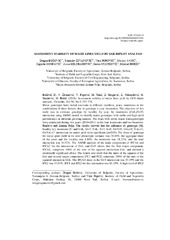Приказ основних података о документу
Assessment stability of maize lines yield by gge-biplot analysis
| dc.creator | Božović, Dragan | |
| dc.creator | Živanović, Tomislav | |
| dc.creator | Popović, Vera | |
| dc.creator | Tatić, Mladen | |
| dc.creator | Gospavić, Zagorka | |
| dc.creator | Miloradović, Zoran | |
| dc.creator | Stanković, Goran | |
| dc.creator | Dokić, Milorad | |
| dc.date.accessioned | 2021-04-26T19:37:10Z | |
| dc.date.available | 2021-04-26T19:37:10Z | |
| dc.date.issued | 2018 | |
| dc.identifier.issn | 0534-0012 | |
| dc.identifier.uri | http://fiver.ifvcns.rs/handle/123456789/1743 | |
| dc.description.abstract | Maize genotypes have varied reactions in different localities, years, treatments or the combination of these factors, due to genotype x year interaction. The objective of this study was to estimate genotype by locality, by year, by treatments (GxLxYxT) interaction using AMMI model, to identify maize genotypes with stable and high yield performance in different growing seasons. The trials with seven maize lines/genotypes were conducted during two years (2010-2011) at the four treatments and two locations: Pancevo and Zemun Polje. The results showed that the influence of: genotype (G), locality (L), treatment (T) and GxL, GxT, YxL, YxT, LXT, GxYxT, GxLxT, YxLxT, GxYxLxT interaction, on maize yield were significant (p lt 0.01). The share of genotype for maize grain yield in the total phenotypic variance was 21.16%, the aggregate share of the years and the locality was 6.10%, the treatment was 18.22%, and the total interaction was 54.52%. The AMMI analysis of the main components of IPCA1 and IPCA2 for the interaction of GxL and GxT shows that the first major component, IPCA1, comprises 100% of the sum of the squared interaction GxL and showed a statistically significant effect. The results also show that the sums of the squares of the first and second major components (PC1 and PC2) constitute 100% of the sum of the squared interaction GxL. The IPCA1 share in the GxT interaction was 47.39% and the IPC2 was 37.94%. IPC1 and IPC2 for this interaction was 85.33%. A high level of IPC2 indicates a significant treatment effect. The results of AMI analysis show that there is a significant difference between the genotype reactions to different ecological conditions for investigated factors. It also provided better insight in specific association between maize grain yield, locality, treatment and meteorological variables. Among the tested maize lines/genotypes, L-5, L-4 and L-6 could be separated as highest yielding genotypes, however L-5 could be recommended for further breeding program and in large-scale seed production due to its stable and high yielding performance. | en |
| dc.publisher | Društvo genetičara Srbije, Beograd | |
| dc.relation | FAO Project | |
| dc.relation | Benefit-sharing Fund of the International Treaty on Plant Genetic Resources for Food and Agriculture, FAO | |
| dc.relation | info:eu-repo/grantAgreement/MESTD/Technological Development (TD or TR)/31023/RS// | |
| dc.rights | openAccess | |
| dc.rights.uri | https://creativecommons.org/licenses/by-nc-nd/4.0/ | |
| dc.source | Genetika-Belgrade | |
| dc.subject | Zea mays L. | en |
| dc.subject | lines | en |
| dc.subject | AMMI analysis | en |
| dc.subject | GxYxLxT interaction | en |
| dc.subject | yield | en |
| dc.title | Assessment stability of maize lines yield by gge-biplot analysis | en |
| dc.type | article | |
| dc.rights.license | BY-NC-ND | |
| dc.citation.epage | 770 | |
| dc.citation.issue | 3 | |
| dc.citation.other | 50(3): 755-770 | |
| dc.citation.rank | M23 | |
| dc.citation.spage | 755 | |
| dc.citation.volume | 50 | |
| dc.identifier.doi | 10.2298/GENSR1803755B | |
| dc.identifier.fulltext | http://fiver.ifvcns.rs/bitstream/id/665/1740.pdf | |
| dc.identifier.scopus | 2-s2.0-85059594977 | |
| dc.identifier.wos | 000457340900001 | |
| dc.type.version | publishedVersion |


